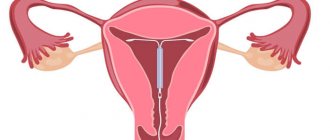Pharmacological properties of the drug Nuvaring
Pharmacodynamics. NuvaRing contains etonogestrel and ethinyl estradiol. Etonogestrel is a progestogen, a derivative of 19-nortestosterone, which has a high affinity for progesterone receptors in target organs. Ethinyl estradiol is an estrogen widely used in contraceptives. The contraceptive effect of NuvaRing is based on different mechanisms, the main one of which is inhibition of ovulation. The Pearl Index for the NuvaRing ring is 0.765. In addition to protecting against pregnancy, NuvaRing regulates the menstrual cycle, reduces the severity of pain and the intensity of bleeding (which reduces the risk of developing iron deficiency anemia). There is evidence of a reduced risk of developing endometrial and ovarian cancer. Pharmacokinetics. Etonogestrel Etonogestrel, released from the NuvaRing, is quickly absorbed by the vaginal mucosa. The maximum plasma concentration of etonogestrel (average 1700 pg/ml) is achieved approximately 1 week after insertion of the ring. Then after 3 weeks the concentration slowly decreases to 1400 pg/ml. Absolute bioavailability is 100% (which is higher than when using oral contraceptives). Etonogestrel combines with serum albumin and sex hormone binding globulin. The volume of distribution of etonogestrel is 2.3 l/kg body weight. Etonogestrel is metabolized by hydroxylation and reduction to form sulfate and glucuronide conjugates. The rate of elimination of metabolites from blood plasma is on average 3.5 l/h. There was no interaction of etonogestrel with concomitantly taken ethinyl estradiol. The concentration of etonogestrel in the blood plasma decreases in 2 stages. The half-life at the last stage is about 29 hours. Etonogestrel and its metabolites are excreted in urine and bile in a ratio of 1.7:1. The half-life of metabolites is about 6 days. Ethinyl estradiol Ethinyl estradiol, released from the NuvaRing ring, is rapidly absorbed by the vaginal mucosa. The maximum concentration in blood plasma (about 35 pg/ml) is reached approximately on the 3rd day after insertion of the ring and decreases to 18 pg/ml after 3 weeks. The absolute bioavailability is 56%, which corresponds to the level of bioavailability of ethinyl estradiol when taken orally. Ethinyl estradiol is metabolized by aromatic hydroxylation to form hydroxylated and methylated metabolites. These metabolites are present both in the free state and as conjugates of glucuronides and sulfates. The effective clearance is approximately 35 l/h. The level of ethinyl estradiol in the blood plasma decreases in 2 stages. The half-life at the last stage is characterized by significant individual differences with an average value of 34 hours. Ethinyl estradiol is not excreted unchanged. Ethinyl estradiol metabolites are excreted in urine and bile in a ratio of 1.3:1. The half-life of metabolites is 1.5 days.
Use of the drug Nuvaring
The NuvaRing ring is inserted into the vagina by the woman herself. The doctor should inform the woman how to insert and remove NuvaRing. To insert the ring, take a comfortable position: stand with your leg raised, sit down or lie down. Before insertion, the NuvaRing ring must be compressed and inserted into the vagina so that it fits well. The exact position of the ring in the vagina is not decisive for the contraceptive effect. From the moment of insertion, the ring should remain in the vagina continuously for 3 weeks. If the ring is accidentally removed (for example, when removing a tampon), it should be rinsed with cold or cool (not hot) water and immediately reinserted into the vagina. NuvaRing should be removed after 3 weeks on the same day of the week when it was inserted. After a week's break, a new ring must be inserted. The NuvaRing can be removed by lifting it with your index finger or holding the ring between your index and middle fingers. Bleeding associated with discontinuation of the drug usually begins 2-3 days after NuvaRing is removed and may continue until the day the next ring is inserted. Start of use If hormonal contraceptives were not used during the previous menstrual cycle, NuvaRing must be administered between the 1st and 5th day of the cycle, but no later than the 5th day from the start of menstruation, even if the bleeding has not yet stopped. During the first 7 days of using NuvaRing, it is recommended to additionally use a condom. Switching from combined oral contraceptives (COCs) NuvaRing must be administered the next day after a break in taking the drug or after a period of taking placebo tablets in a course of COCs. Switching from progestogen-only medications (mini-pill, implant or injection) or from a progestogen-releasing intrauterine system A woman taking the mini-pill can switch to NuvaRing any day. When using an implant or intrauterine system that releases progestogen, the transition occurs on the day of its removal, and when using injections, on the day of the next scheduled injection. In all of these cases, the woman should use an additional barrier method during the first 7 days. After an abortion in the first trimester The use of the ring can be started immediately after the abortion. There is no need for additional methods of contraception. If the use of NuvaRing immediately after an abortion is undesirable, you should follow the recommendations (see “If hormonal contraceptives were not used during the previous menstrual cycle”). After childbirth or abortion in the second trimester Women are recommended to start using the ring during the 4th week after childbirth or abortion in the second trimester. If the ring is used later, it is recommended to additionally use the barrier method during the first 7 days of using NuvaRing. If you have sexual intercourse during this period, before introducing NuvaRing, you must first rule out pregnancy or wait until the next menstruation. Deviations from the recommended regimen Contraceptive effectiveness and menstrual cycle control may be impaired if a woman does not adhere to the recommended regimen. To avoid a decrease in the effectiveness of contraception if the regimen is violated, the following recommendations should be followed. If the break in using the ring is prolonged. If you miss replacing the ring, a new ring should be inserted as soon as possible and during the first 7 days an additional barrier method of contraception (condom) should be used. If you had sexual intercourse during the break from using the ring, the risk of pregnancy should be assessed. The longer the break, the higher the risk of pregnancy. If the ring is temporarily absent from the vagina, the NuvaRing ring should be constantly in the vagina for 3 weeks. Accidental removal and absence of a ring in the vagina for ≤3 hours does not affect the effectiveness of contraception. The ring should be reinserted as quickly as possible, no later than after 3 hours. The absence of the ring in the vagina for 3 hours reduces the effectiveness of contraception. You should insert the ring as soon as possible and use a barrier method of contraception (condom) for 7 days from the time the ring is inserted into the vagina. If the first of these 7 days falls on the 3rd week of using the ring, NuvaRing should be used for longer than 3 weeks. Then the ring should be removed and a new one inserted after a week's break. If the ring is removed for a period of 3 hours during the 1st week of using the ring, the risk of pregnancy should be weighed. When increasing the period of use of the ring, the maximum period of use of NuvaRing without loss of contraceptive effectiveness is 4 weeks. You should take a week's break from using the ring and then insert a new one. Keeping NuvaRing in the vagina for 4 weeks reduces the effectiveness of contraception, and pregnancy should be ruled out before inserting a new ring. If the recommended regimen is violated and menstruation is delayed during the next break in using the ring, pregnancy should be ruled out before introducing a new ring. Change in the date or delay of menstruation To delay menstruation, a new ring should be inserted without a week's break. The new ring should also be used for 3 weeks. During this period, a woman may experience light or thick bleeding. In the future, after the usual one-week break from using the ring, regular use of NuvaRing should be resumed. Changing the period of menstruation, moving it to another day of the week that does not coincide with the planned day of insertion of the ring, should be done by shortening the next break by the required number of days. The shorter the previous break, the higher the risk of no menstruation, or the appearance of thick or light bleeding during the next break.
What are the advantages of a vaginal ring?
- The method is convenient and easy to use.
- 99% guarantee.
- Don't think about contraception for three weeks.
- There is no effect on the liver and gastrointestinal tract.
- Minimum dose of hormones.
- Does not promote weight gain.
- Menstruation becomes regular and less painful.
- Reduce the likelihood of developing certain gynecological diseases.
Contraindications for using this method of contraception are the same as for birth control pills.
Contraindications to the use of the drug Nuvaring
Venous thrombosis with/without pulmonary embolism currently or in history; arterial thrombosis (cerebrovascular accident, myocardial infarction) or precursors of thrombosis (angina pectoris or transient ischemic cerebrovascular accident) currently or in history; predisposition to venous or arterial thrombosis with or without the inclusion of such hereditary disorders as activated protein C resistance (APC), antithrombin III deficiency, protein C deficiency, protein S deficiency, hyperhomocysteinemia, antiphospholipid antibodies (anticardiolipin antibodies, lupus anticoagulant). migraine with focal neurological symptoms; diabetes mellitus with vascular complications; pancreatitis or previous pancreatitis, which is accompanied by hypertriglyceridemia; severe liver disease (until liver function indicators return to normal values); liver tumor (benign or malignant; present or in history); hormone-dependent malignant tumors (diagnosed or suspected); vaginal bleeding of unknown etiology; diagnosed or probable pregnancy; breastfeeding period; hypersensitivity to any component of the drug. Use with caution in diabetes mellitus; obesity (body mass index 30 kg/m2); AH (arterial hypertension); atrial fibrillation; heart valve diseases; dyslipoproteinemia; diseases of the liver and gall bladder; Crohn's disease and ulcerative colitis; sickle cell anemia; systemic lupus erythematosus; hemolytic uremic syndrome; epilepsy; smoking over the age of 35; prolonged immobilization; extensive surgical interventions; fibrocystic mastopathy; uterine fibroids; congenital hyperbilirubinemia (Gilbert, Dubin-Johnson and Rotor syndrome); chloasma (avoid sun exposure and ultraviolet radiation); any of the conditions in which the woman will not be able to properly insert or may lose the ring; cervical prolapse; cystocele or rectocele, severe or chronic constipation.
Side effects of the drug Nuvaring
Adverse drug reactions reported in women using NuvaRing® are listed in the table below. The most appropriate MedDRA term (version 11.0) to describe the specific adverse event is appended.
Systems and organs | Frequent ≥ 1/100 | Uncommon ≤1/100, ≥1/1000 | Post marketing (1) |
| Infections and infestations | Vaginal infection | Cervicitis, cystitis, urinary tract infection | |
| The immune system | Increased sensitivity | ||
| Metabolism and nutritional disorders | Increased appetite | ||
| Mental disorders | Depression, decreased libido | Change of mood | |
| CNS | Headache, migraine | Dizziness, hypoesthesia | |
| Vision | Visual impairment | ||
| The cardiovascular system | Bring blood to your face | ||
| Digestive system | Abdominal pain, nausea | Bloating, diarrhea, vomiting, constipation | |
| Skin and subcutaneous tissues | Acne | Alopecia, eczema, itching, rashes | Hives |
| Musculoskeletal and connective tissue | Back pain, muscle cramps, pain in limbs | ||
| urinary system | Dysuria, urinary urgency, polakiuria | ||
| Reproductive system and mammary gland | Soreness, itching of the female genitals, dysmenorrhea, pelvic pain, vaginal discharge | Amenorrhea, discomfort in the mammary glands, enlarged mammary glands, cervical polyp, coital bleeding, dyspareunia, cervical ectropia, fibrocystic mastopathy, menorrhagia, metrorrhagia, pelvic discomfort, premenstrual syndrome, contractions of the uterine muscles, burning pain in the vagina, unpleasant vaginal odor, vaginal pain, vulvovaginal discomfort, vulvovaginal dryness. | Diseases of the genital organ in men2 |
| General and administration site disorders | Fatigue, irritability, discomfort, swelling, foreign body sensation | ||
| Other | Weight gain | Hypertension | |
| Injuries and procedural complications | Discomfort while using the ring, loss of the vaginal contraceptive ring | Complication when using a contraceptive ring, ring breakage |
1) List of adverse events based on spontaneous report. It is impossible to determine the exact frequency. 2) Diseases of the genital organ in men (including reports of local reactions).
Special instructions for the use of the drug Nuvaring
Special warnings and special precautions. If any of the following conditions/risk factors occur, the benefits or risks of continued use of NuvaRing should be considered for each individual woman and discussed with the patient before she decides to use this drug. In case of exacerbation, intensification or first manifestations of any of these conditions, a woman should consult a doctor. The doctor determines the need to use the drug NuvaRing. All data given below are based on epidemiological data obtained from the use of combined oral contraceptives. There are no epidemiological data obtained from the vaginal method of using hormones, but warnings are considered acceptable when using the drug NuvaRing.
1. Circulatory disorders
- Epidemiological studies suggest an association between the use of COCs and an increased risk of arterial and venous thrombosis and thromboembolic diseases such as myocardial infarction, stroke, deep venous thrombosis and pulmonary embolism. These phenomena occur rarely.
- The use of any combined oral contraceptives by women increases the risk of developing venous thromboembolism (VTE) compared to those who do not take COCs. There is a particularly high risk of developing venous thromboembolism in the first year of using COCs. This increased risk is less than the pregnancy-associated risk of VTE, which is estimated to be 6 per 10,000 pregnancies. VTE is fatal in 1–2% of cases. It is unknown how NuvaRing affects the risk of VTE compared to other combined hormonal contraceptives.
- Very rarely, thrombosis has been reported to occur in other blood vessels, such as the hepatic, mesenteric, renal, cerebral or retinal veins and arteries, in women using COCs. There is no general consensus on whether these cases are related to the use of COCs.
- Symptoms of venous or arterial thrombotic cases may include: uncharacteristic unilateral lower extremity pain and/or swelling; sudden severe pain in the chest, regardless of whether it radiates to the left arm; sudden dyspnea; sudden attack of coughing; any unusual, severe, prolonged headache; sudden partial or complete loss of vision; diplopia; slurred speech or aphasia; vertigo; collapse with or without focal epileptic seizure; weakness or severe numbness on one side or part of the body; impaired coordination of movements; symptoms of an “acute” abdomen.
- The risk of venous thromboembolism increases due to: age; family history (presence of venous or arterial thromboembolism in siblings or parents at a relatively early age). If there is a suspicion of a hereditary predisposition, the woman should be referred for consultation with a specialist before making a decision about the use of COCs; prolonged immobilization, significant surgical interventions, various surgical interventions on the lower extremities or severe injuries. In these cases, it is recommended to stop taking the drug (in case of planned surgery, at least four weeks in advance) and not to resume it for two weeks after complete remobilization; obesity (body mass index more than 30 kg/m2); also in the presence of superficial thrombophlebitis and varicose veins. There is no consensus on the possible role of these conditions in the etiology of venous thrombosis.
- The risk of arterial thromboembolism increases due to: – age; – smoking (the more a person smokes and the older he is, the greater the risk, especially in women over 35 years old); – dislipoproteinemia; – obesity (body mass index ≤30 kg/m2); – AH (arterial hypertension); – migraine; – heart valve diseases; – atrial fibrillation; – a burdened family history (for example, arterial thrombosis in a brother/sister or parents at a relatively early age). If a hereditary predisposition is suspected, the woman should be referred to a specialist for advice before deciding to use hormonal contraception.
- Biochemical factors that may indicate hereditary or acquired predisposition to venous or arterial thrombosis include activated protein C (APC) resistance, hyperhomocysteinemia, antithrombin III deficiency, protein C deficiency, protein S deficiency, antiphospholipid antibodies (anticardiolipin antibodies, lupus anticoagulant) .
- Other medical conditions that have been associated with adverse circulatory effects include diabetes mellitus, SLE, hemolytic uremic syndrome, chronic inflammatory bowel disease (Crohn's disease and ulcerative colitis), and sickle cell disease.
- The increased risk of thromboembolism in the postpartum period should be considered (see section "Use during pregnancy or lactation").
- An increase in the frequency or intensity of migraine while taking COCs (which may precede cerebrovascular accident) may be a reason for immediate discontinuation of COC use.
2. Tumors
- The highest risk factor for developing cervical cancer is persistent infection with the human papillomavirus (HPV). Epidemiological studies have suggested that long-term use of COCs may contribute to an increased risk of cervical cancer, but the extent to which this is related to confounding effects, such as increased frequency of cervical screening and variation in sexual behavior, including barrier contraceptive use and causal associations, is unclear. It is unknown how this effect relates to NuvaRing.
- A meta-analysis of 54 epidemiological studies found that there was a small increase in the relative risk (RR = 1.24) of developing breast cancer in diagnosed women who were currently using COCs. The high risk gradually decreases over 10 years after stopping the use of COCs. Because breast cancer rarely occurs in women under 40 years of age, the number of breast cancer diagnoses among current or former COC users is small compared to the overall risk of developing breast cancer. Breast cancer diagnosed in women is generally less advanced clinically than cancer diagnosed in people who have never used COCs. The pattern of increased risk observed may be due to the early diagnosis of breast cancer in women who used COCs, the biological effects of COCs, or a combination of both factors.
- Benign liver tumors and very rarely malignant liver tumors have been rarely reported in women who use COCs. In isolated cases, these tumors caused intra-abdominal bleeding that threatened life. Therefore, liver tumor should be considered in the differential diagnosis if women who use NuvaRing experience severe upper abdominal pain, liver enlargement, or signs of intra-abdominal bleeding.
3. Other states
- When using COCs in women with hypertriglyceridemia or a family history of it, there may be a risk of developing pancreatitis.
- Although slight increases in blood pressure have been reported in many women taking hormonal contraceptives, clinically significant increases are rare. The exact relationship between the use of hormonal contraceptives and hypertension (arterial hypertension) has not been established. However, if persistent clinically significant hypertension (arterial hypertension) develops while using NuvaRing, the doctor should stop using the ring for a while and treat the hypertension (arterial hypertension). The use of the drug NuvaRing can be resumed if blood pressure levels are achieved with the help of antihypertensive therapy.
- The occurrence or worsening of the following conditions has been reported during pregnancy and the use of hormonal contraceptives, but the evidence for an association with their use is inconclusive: jaundice and/or pruritus associated with cholestasis; formation of gallstones; porphyria; SLE; hemolytic uremic syndrome; chorea; herpes during pregnancy; hearing loss associated with otosclerosis; hereditary angioedema.
- Acute or chronic liver dysfunction may require discontinuation of the drug NuvaRing until liver function tests normalize. Recurrence of cholestatic jaundice and/or pruritus associated with cholestasis that first occurred during pregnancy or previous use of sex steroids requires discontinuation of ring use.
- Estrogens and progestogens can affect peripheral insulin resistance and impaired glucose tolerance, and there is no need to change the treatment regimen of diabetic patients who use hormonal contraception. However, women with diabetes should be closely monitored while using NuvaRing, especially in the first months of use.
- Worsening of Crohn's disease and ulcerative colitis has been reported in association with the use of hormonal contraceptives.
- Chloasma may occur periodically, especially in women with a history of chloasma during pregnancy. Women who are prone to chloasma are advised to avoid exposure to the sun or exposure to ultraviolet radiation while taking NuvaRing.
If a woman has any of the following conditions, she may not be able to insert the NuvaRing correctly or may lose the ring: cervical prolapse, cystocele and/or rectocele, severe or chronic constipation. Very rarely, NuvaRing has been reported to be accidentally inserted into the urethra and possibly end up in the bladder. Therefore, the possibility of ring misplacement should be considered in the differential diagnosis when symptoms of cystitis occur. While using the drug NuvaRing, women may sometimes experience vaginitis. There is no evidence that the effectiveness of the drug NuvaRing is affected by the treatment of vaginitis or that the use of the drug NuvaRing affects the effectiveness of the treatment of vaginitis (see Section Interaction with other drugs and other types of interactions.). Very rarely, it was reported that the ring grew into the vaginal mucosa, which required the intervention of a specialist doctor. Medical supervision Before using or resuming the use of NuvaRing, it is necessary to consult a doctor with a thorough collection of anamnestic data and a medical examination. In the future, the doctor’s examination should be repeated at least once a year with blood pressure measurement, examination of the mammary glands, abdominal and pelvic organs, cytological examination of the cervix and relevant laboratory tests. The patient should be informed that the use of NuvaRing does not protect against HIV infection (AIDS) and other sexually transmitted diseases. Reduced effectiveness The effectiveness of NuvaRing may be reduced if the regimen is not followed or if certain medications are taken simultaneously. Deterioration of control of the menstrual cycle While using the drug NuvaRing, (minor or heavy) bleeding may be observed. If irregular bleeding occurs after previous regular cycles while using NuvaRing in accordance with the recommended regimen, non-hormonal causes should be considered and adequate diagnostics should be instituted to rule out pregnancy or malignancy, which may include curettage. Some women may not experience any bleeding during a break from using the ring. If NuvaRing was used in accordance with the recommendations given in the “Method of administration and dosage” section, then the possibility of pregnancy is low. However, if NuvaRing was used without following such recommendations before the first case of absence of bleeding during the period without using the ring, or if there were no bleedings twice in a row, pregnancy should be excluded before continuing to use the drug NuvaRing. Damage to the ring In very rare cases, the NuvaRing ring has been reported to become detached during use (see Section Interactions with other medicinal products or other types of interactions). Since the core of the NuvaRing drug is solid, its contents remain intact and will not significantly affect the release of hormones. If the ring becomes disconnected, it may fall out. If NuvaRing is damaged, the woman should throw away the ring and replace it with a new one. Removal NuvaRing may reportedly be removed if the ring is not inserted correctly, when removing a tampon, during coitus, or in cases of severe and chronic constipation. Therefore, a woman is recommended to regularly check for the presence of NuvaRing in the vagina. If NuvaRing is accidentally removed, the woman should follow the instructions. Effect of ethinyl estradiol and etonogestrel on men The extent and possible pharmacological effects of ethinyl estradiol and etonogestrel on sexual partners through absorption through the mucous membrane of the male genital organ have not been studied. Use of the drug during pregnancy or breastfeeding Pregnancy is a contraindication for the use of NuvaRing. If pregnancy occurs, the ring should be removed. Estrogens can reduce the amount and change the composition of breast milk. It is not recommended to use NuvaRing during breastfeeding (until the baby is completely weaned). NuvaRing does not affect concentration or the ability to drive.
Disadvantages of this method:
- Does not protect against sexually transmitted diseases.
- The vaginal microflora may change.
- There may be intermenstrual discharge.
- There are contraindications - the same as for combined hormonal contraceptives (thrombosis, hypertension, diabetes, mastopathy).
Vaginal rings as a method of contraception are recommended not only for young girls, but also for women who do not want to take birth control pills every day. A vaginal ring is a reliable, effective and convenient way to protect against unwanted pregnancy in all respects. And if a woman is protected, then she feels much more confident in an intimate relationship with a man.
Previous post Causes of uterine cancer
Next entry Intrauterine device MIRENA
Drug interactions Nuvaring
Interactions between hormonal contraceptives and other medications may cause irregular bleeding and/or a lack of contraceptive effect. Hepatic metabolism: Interactions may occur with drugs that induce microsomal enzymes that can lead to increased metabolism of sex hormones (eg, phenytoin, phenobarbital, primidone, carbamazepine, rifampicin, oxcarbazepine, topiramate, felbamate, ritonavir, griseofulvin and preparations containing St. John's wort ). Women taking any of these drugs should temporarily use a barrier method of contraception in addition to using NuvaRing or choose another method of contraception. When using drugs that induce microsomal enzymes, a barrier method of contraception should be used during the course of using such drugs and for another 28 days after stopping their use. If the course of concomitant drug therapy exceeds the 3 weeks during which the ring is used, the next one should be administered immediately, without the usual one-week break. The contraceptive effect of the drug may also be reduced when taking certain antibiotics at the same time, for example, penicillins and teracyclines. The mechanism of this effect has not been identified. In pharmacokinetic interaction studies, oral administration of amoxicillin (875 mg, twice daily) or doxycycline (200 mg on the first day, followed by 100 mg daily) for 10 days of NuvaRing did not significantly affect the pharmacokinetics of etonogestrel and ethinyl estradiol (EE). ). Women taking antibiotics (except amoxilin and doxycycline) should use a barrier method of contraception for up to 7 days after stopping. If concomitant drug use exceeds 3 weeks of the ring cycle, a new ring must be inserted immediately without taking the usual break before using the next ring. According to pharmacokinetic data, intravaginally administered antimycotic agents and spermicides do not affect the contraceptive effectiveness and safety of the drug NuvaRing. During concomitant use of antimycotic suppositories, the risk of ring dislocation may be slightly higher. Hormonal contraceptives may affect the metabolism of other drugs. Accordingly, the concentration in blood plasma and tissues can either increase (for example, cyclosporine) or decrease (for example, lamotrigine). Directions for use of concomitant medications should be followed to identify potential interactions. The use of contraceptive steroids may affect the results of some laboratory tests, including biochemical indicators of liver, thyroid, adrenal and kidney function, plasma protein levels (for example, levels of corticosteroid binding globulin and sex hormone binding globulin), lipid fractions and lipoproteins, indicators of carbohydrate metabolism, coagulation and fibrinolysis. Such changes usually remain within normal laboratory values. Interaction with tampons. Pharmacokinetic data show that the use of tampons does not affect the systemic absorption of hormones released by NuvaRing. In rare cases, NuvaRing may be removed when the tampon is removed.
Vaginal ring Nova Ring
There are many methods of contraception in the world.
Therefore, a modern woman is faced with the question of choosing, “what to use, what is more effective, what will suit me best?” Each contraceptive method has its own disadvantages and advantages. Therefore, doctors and scientists around the world are trying to invent more and more effective and easy-to-use methods of contraception. In the 70s of our century, such a method was invented and it is called a vaginal (vaginal) hormonal ring. This method has aroused great interest among the female half of humanity. In the 90s, the Nova Ring vaginal ring was invented.




